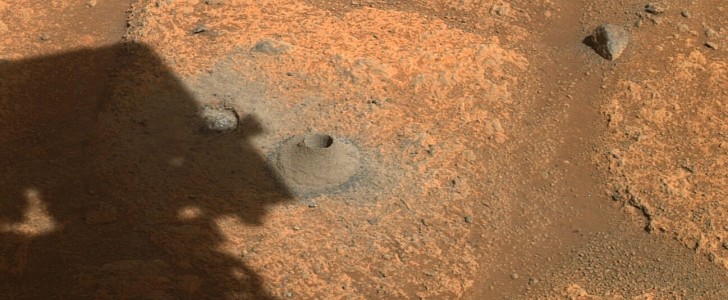While exploring the Jazero Crater on Mars, NASA's Perseverance rover was assigned to collect a sample out of one of the most ancient layers of exposed bedrock. However, the rover’s first attempt to collect Mars samples came up empty.
On February 18th, the car-sized Mars rover landed on the Red Planet, together with its little helicopter buddy, Ingenuity. Up until recently, Perseverance has been supporting Ingenuity, documenting the rotorcraft's historic flights on Mars.
But, on June 1st, the rover got assigned a new job: to explore the oldest geologic features in the Jezero Crater and collect samples from the crater's floor in order to find signs of ancient microbial life. Recently, Perseverance drilled a hole in a Martian rock in preparation for its first attempt to collect a sample.
To extract samples, Perseverance's Sampling and Caching System uses a percussive drill at the end of its 7-foot-long (2-meter-long) robotic arm and a hollow coring bit. The rover also carries 43 titanium sample tubes inside its belly, which are meant to safely transport Red Planet samples back to Earth in great condition.
The images that were taken by Perseverance on August 6th show an empty sample tube. According to NASA, the data sent by the rover indicates that the drill and bit were engaged as expected, and the sample tube was processed as intended afterward.
"The initial thinking is that the empty tube is more likely a result of the rock target not reacting the way we expected during coring, and less likely a hardware issue with the Sampling and Caching System," said Jennifer Trosper, project manager for Perseverance at NASA Jet Propulsion Laboratory.
Currently, the team behind Perseverance is analyzing the data sent by the rover. One of the first steps for Perseverance will be to snap close-up photos of the borehole with its WATSON (Wide Angle Topographic Sensor for Operations and eNgineering) imager, which is placed at the end of the robotic arm. Once the team has a clearer grasp of what went wrong, they will be able to determine when the next sample collection attempt should be made.
But, on June 1st, the rover got assigned a new job: to explore the oldest geologic features in the Jezero Crater and collect samples from the crater's floor in order to find signs of ancient microbial life. Recently, Perseverance drilled a hole in a Martian rock in preparation for its first attempt to collect a sample.
To extract samples, Perseverance's Sampling and Caching System uses a percussive drill at the end of its 7-foot-long (2-meter-long) robotic arm and a hollow coring bit. The rover also carries 43 titanium sample tubes inside its belly, which are meant to safely transport Red Planet samples back to Earth in great condition.
The images that were taken by Perseverance on August 6th show an empty sample tube. According to NASA, the data sent by the rover indicates that the drill and bit were engaged as expected, and the sample tube was processed as intended afterward.
"The initial thinking is that the empty tube is more likely a result of the rock target not reacting the way we expected during coring, and less likely a hardware issue with the Sampling and Caching System," said Jennifer Trosper, project manager for Perseverance at NASA Jet Propulsion Laboratory.
Currently, the team behind Perseverance is analyzing the data sent by the rover. One of the first steps for Perseverance will be to snap close-up photos of the borehole with its WATSON (Wide Angle Topographic Sensor for Operations and eNgineering) imager, which is placed at the end of the robotic arm. Once the team has a clearer grasp of what went wrong, they will be able to determine when the next sample collection attempt should be made.
#SamplingMars is one of my most complicated tasks. Early pics and data show a successful drill hole, but no sample in the tube–something we’ve never seen in testing on Earth. Mars keeps surprising us. We’re working through this new challenge. More to come. https://t.co/XyXBssvKe6 pic.twitter.com/VTNvMA2jqN
— NASA's Perseverance Mars Rover (@NASAPersevere) August 6, 2021






